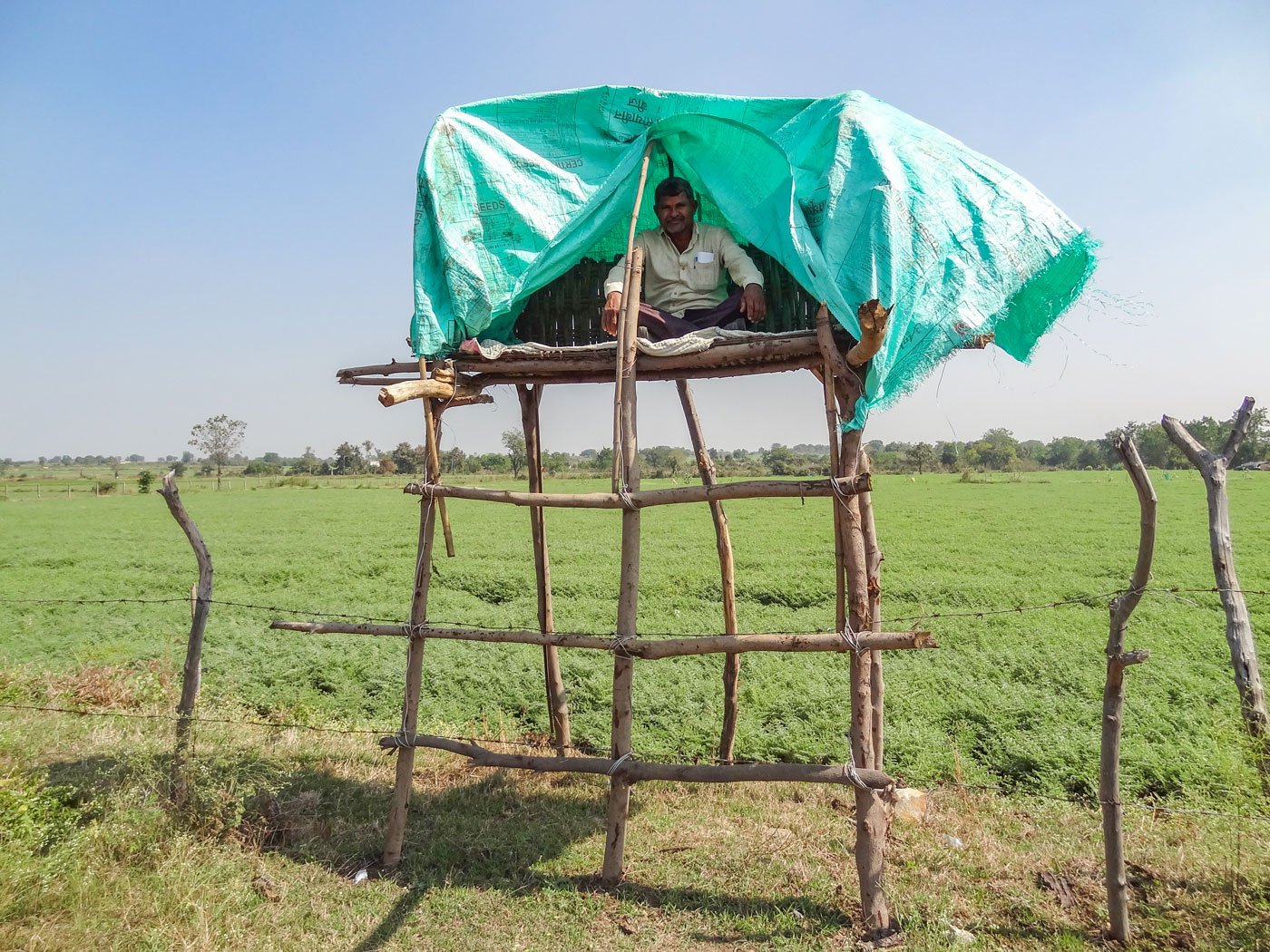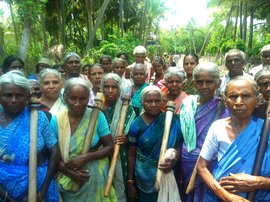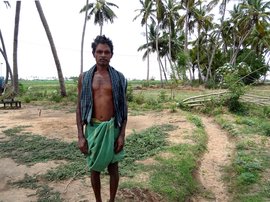Namdeo Tarale slows down as he steps onto his field. The 48-eight-year-old farmer bends to take a close look at a patch of green gram plants that seemed to have been trampled and eaten. It’s a wintry but pleasant morning in February 2022; the sun is soft in the sky above.
“ Ha ek prakarcha dushkalach aahe [It’s a new kind of drought],” he says tersely.
The statement sums up Tarale’s frustration and fears. A farmer with five acres of land, he worries about losing his standing toor and green gram crops that are ready to be harvested after three months of toil. In his 25-plus years of farming, he has witnessed different types of droughts – the meteorological, when the rains fail or are excessive; the hydrological, when the groundwater table recedes to alarming levels; or agricultural, when reduced soil moisture causes crops to fail.
Just when you think you’ve got a good yield, an agitated Tarale says, this calamity steals in on four legs or flies over the farm and flattens the crop, bit by bit.
“Water-hens, monkeys, rabbits in the daytime; deer, nilgai, sambar, boar, tigers at night," he says listing the threats.
" Amhale perta yete saheb, pan vachavta yet nahi [We know how to sow, not how to protect our crop], ” he says in a defeated tone.He usually cultivates green gram, maize, sorghum, and pigeon peas other than cash crops like cotton or soybeans.
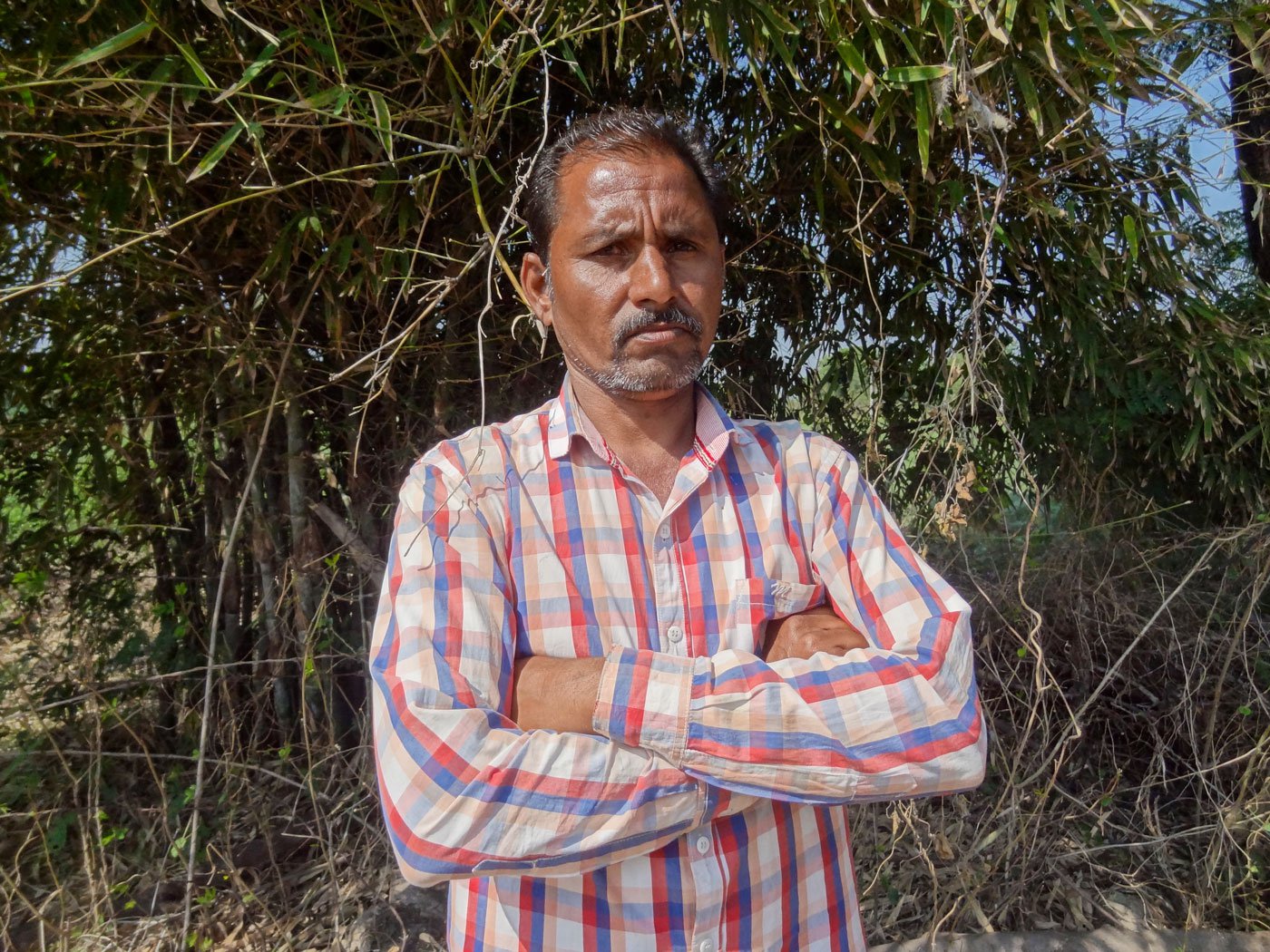
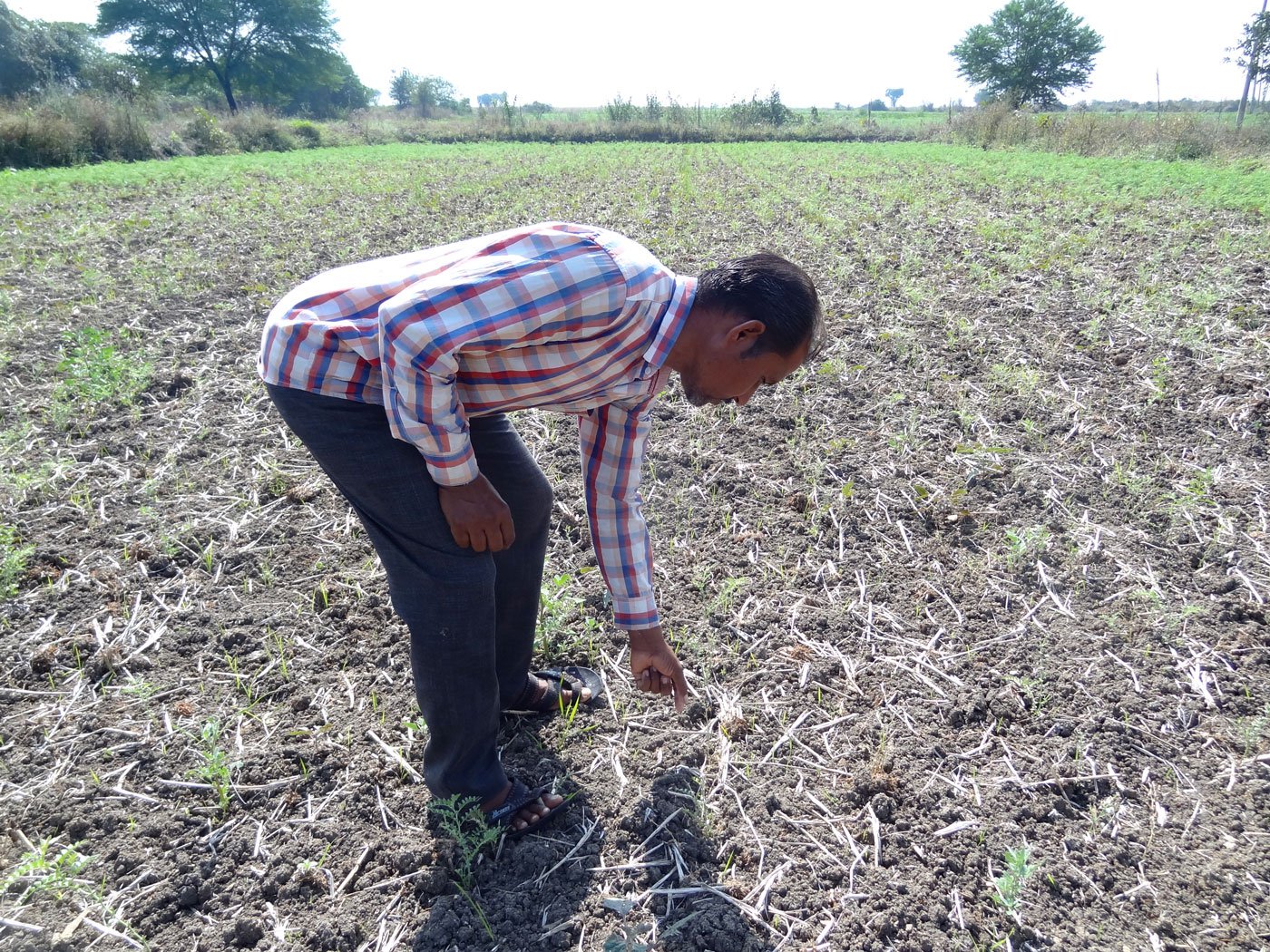
Namdeo Tarale of Dhamani village in Chandrapur district likens the wild animal menace to a new kind of drought, one that arrives on four legs and flattens his crop
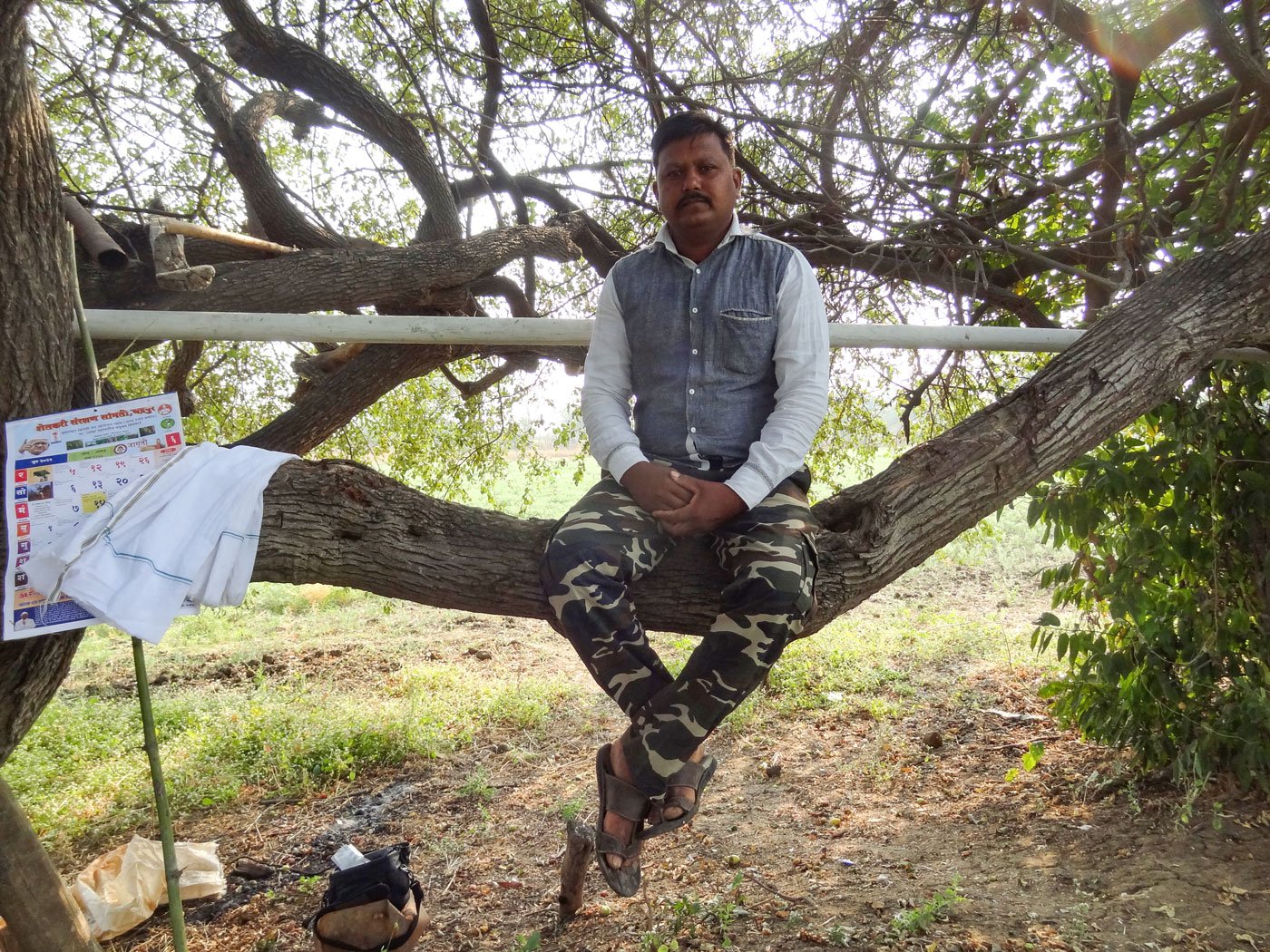
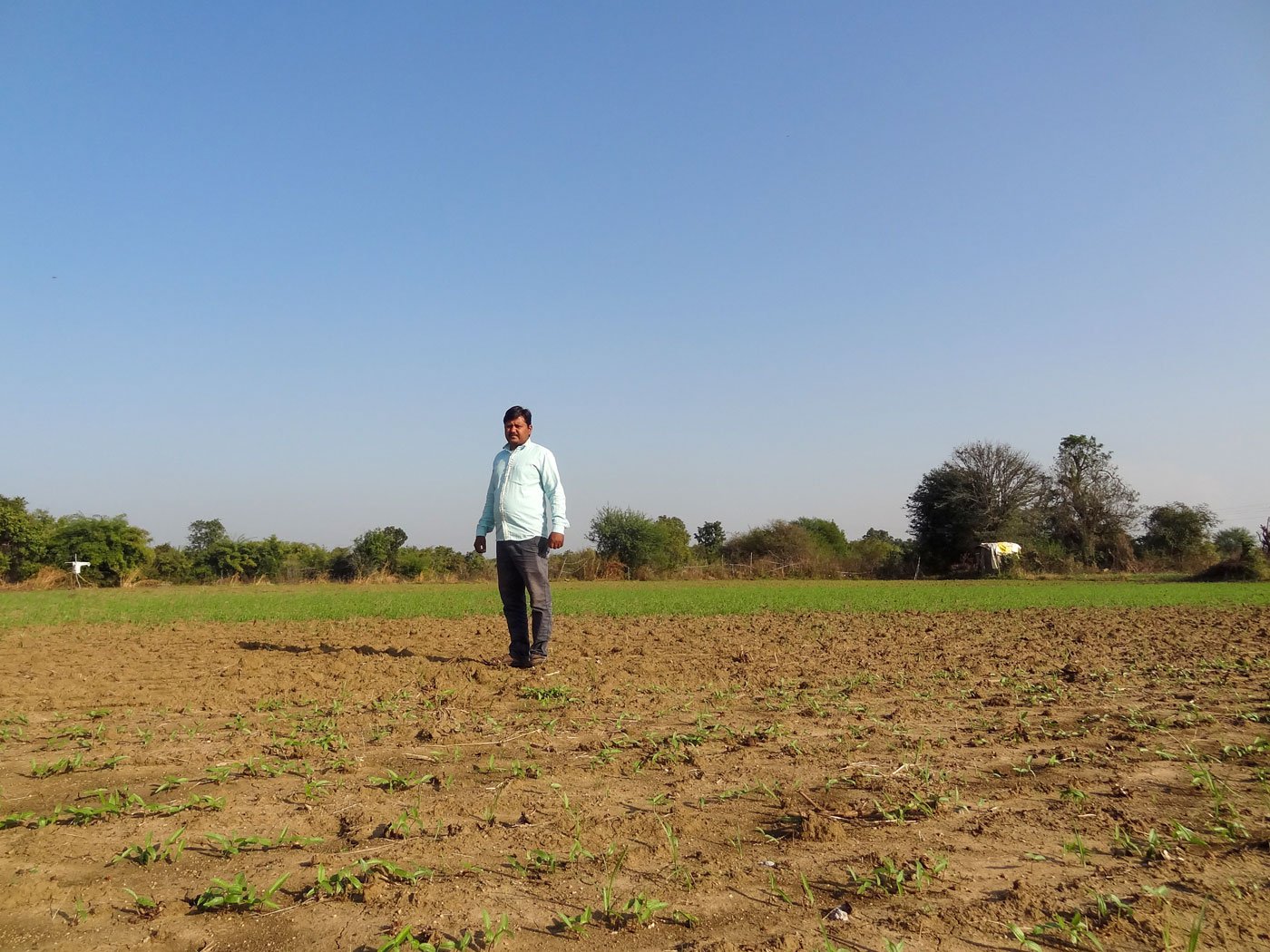
Left: Farmer Gopal Bonde in Chaprala village says, ''When I go to bed at night, I worry I may not see my crop the next morning.' Right: Bonde inspecting his farm which is ready for winter sowing
Tarale isn’t the only agitated farmer in Dhamani village in the forest-abundant and mineral-rich Chandrapur district of Maharashtra. A similar, creeping frustration is gripping cultivators in the scores of villages in and around the Tadoba Andhari Tiger Reserve (TATR) in this district as well as other parts of Maharashtra.
About 25 kilometres away from Tarale’s farm in Chaprala village (Chiprala according to Census 2011), Gopal Bonde, 40, is equally distraught. It’s mid-February 2022 and one can see the quiet devastation on his sprawling 10 acres, half of which is under green gram. The crop has been flattened in patches – as if someone has vengefully rolled on it, uprooted the crop, devoured the beans, and ravaged the fields.
“When I go to bed at night, I worry I may not see my crop next morning,” says Bonde, speaking in January 2023, almost a year after we first met. And so he drives down to his farm on his bike at least a couple of times through the night, in the cold and rain. He often falls sick because of the lack of sleep for long stretches, and the cold. He stops when there’s no crop on the farm, like in the summers. But the rest of the time he must do the rounds every night, particularly during the harvest, he adds, settling in a chair in the front yard of his house on a winter morning.
Wild animals feed on farms round the year: in winter when the fields are green and during the monsoon they graze on nascent shoots. In summer, they rummage at everything on the fields, including water.
Therefore, Bonde must reckon with lurking wild animals “at night when they are most active” and with monetary losses of “a few thousand rupees everyday” if animals destroy the crop. The lurking wild cats kill cattle too. In a decade, he has lost at least two dozen cows in tiger-leopard attacks. Every year, he says, his village loses an average of 20 cattle to tiger attacks. Worse, people suffer injuries or death in wild animal attacks.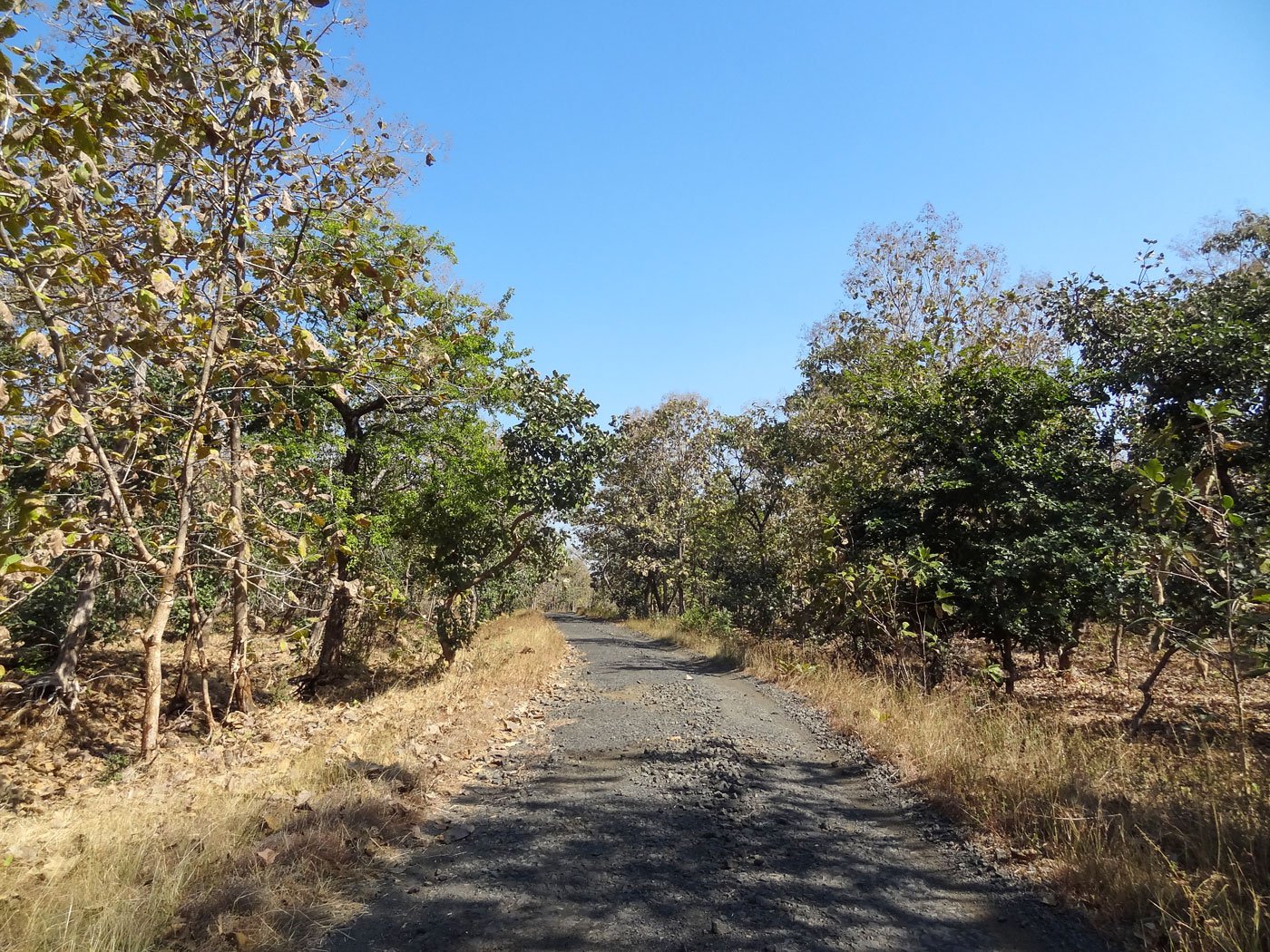
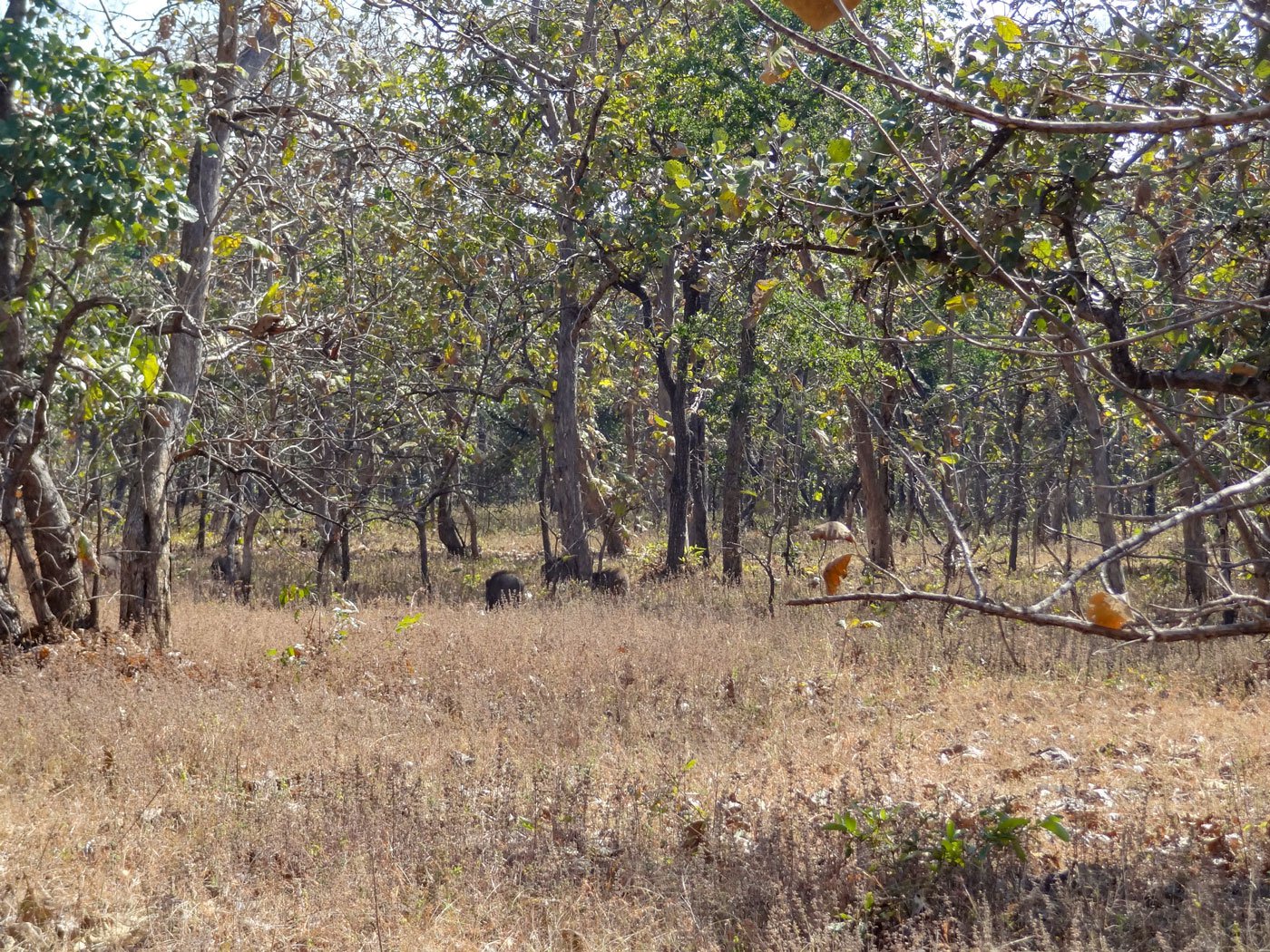
The thickly forested road along the northern fringes of the Tadoba Andhari Tiger Reseve has plenty of wild boars that are a menace for farmers in the area
Among the oldest and largest national parks and wildlife sanctuaries in Maharashtra, the TATR combines the Tadoba National Park and adjoining Andhari Wildlife Sanctuary, sprawled over 1,727 square kilometers across three tehsils of Chandrapur district. The area is one of the hotbeds of man-animal conflict. The central Indian highlands landscape of which TATR is a part has “witnessed an increase in tiger population with 1,161 unique tigers being photographed” compared to an estimated population of 1,033 in 2018, adds the NTCA 2022 report.
Tadoba accounts for about 83 of the state’s 315-plus tigers, according to the 2018 report of the National Tiger Conservation Authority (NTCA).
Across tens of villages in this part, right up to Vidarbha, farmers like Tarale or Bonde – who have no other livelihood options but farming, try out bizarre tricks to fend off wild animals. They construct fences including solar battery-powered ones that emit shocks, swathe their farms with cheap and colourful nylon sarees, even the boundary of forests; burst firecrackers; station herds of dogs and play the latest Chinese gadgets blaring animal noises.
Nothing works.
Bonde’s Chaprala and Tarale’s Dhamani villages lie close to the buffer zone of the TATR, a dry deciduous forest, one of India’s important protected tiger areas, and a tourist destination. Here, because of the proximity to the core area of the protected forest, farmers are frequently troubled by wild animal raids. A buffer zone has human habitation and surrounds the protected forest’s core, the latter is off-limits for human activity and managed by the state forest department.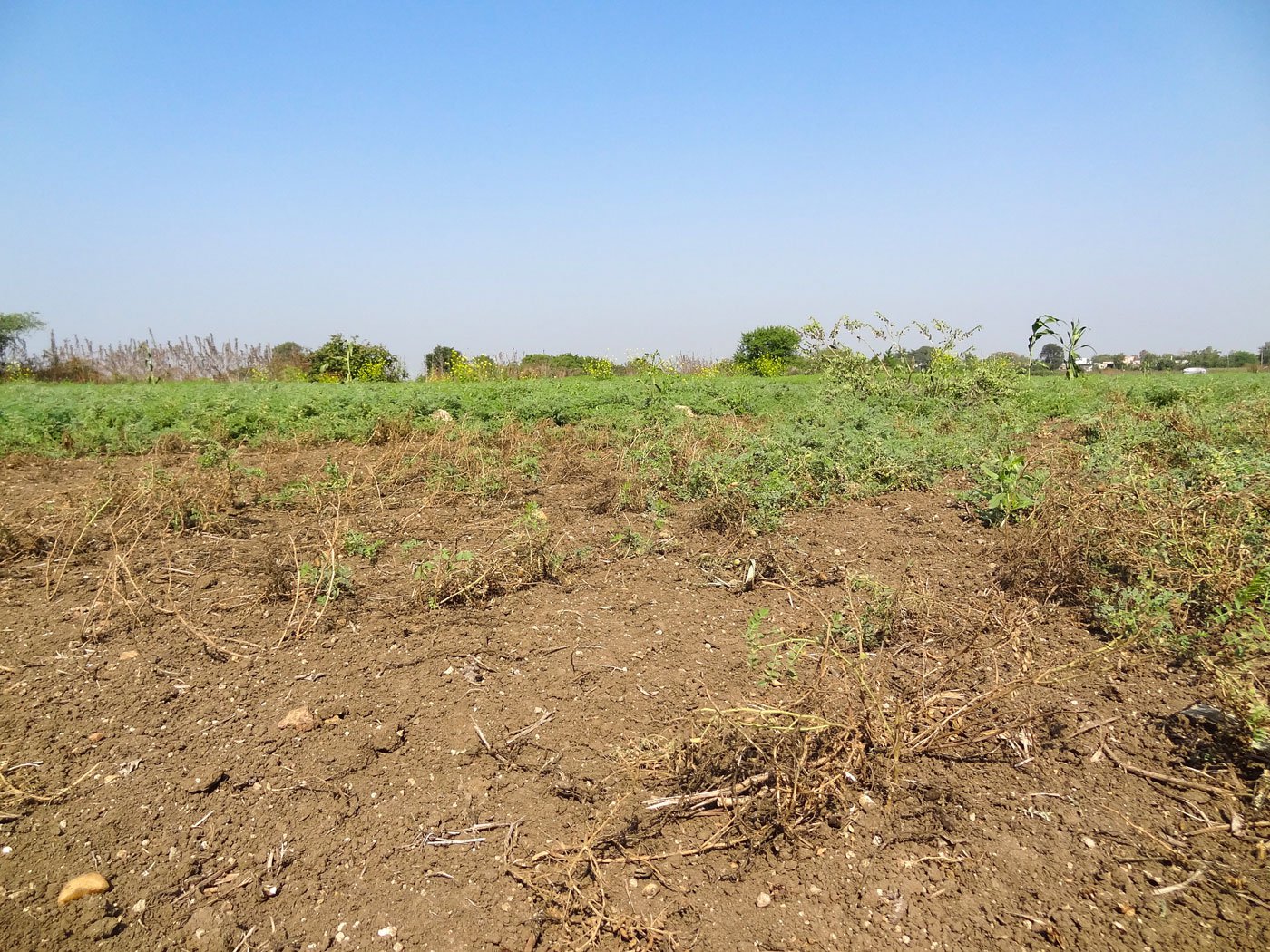
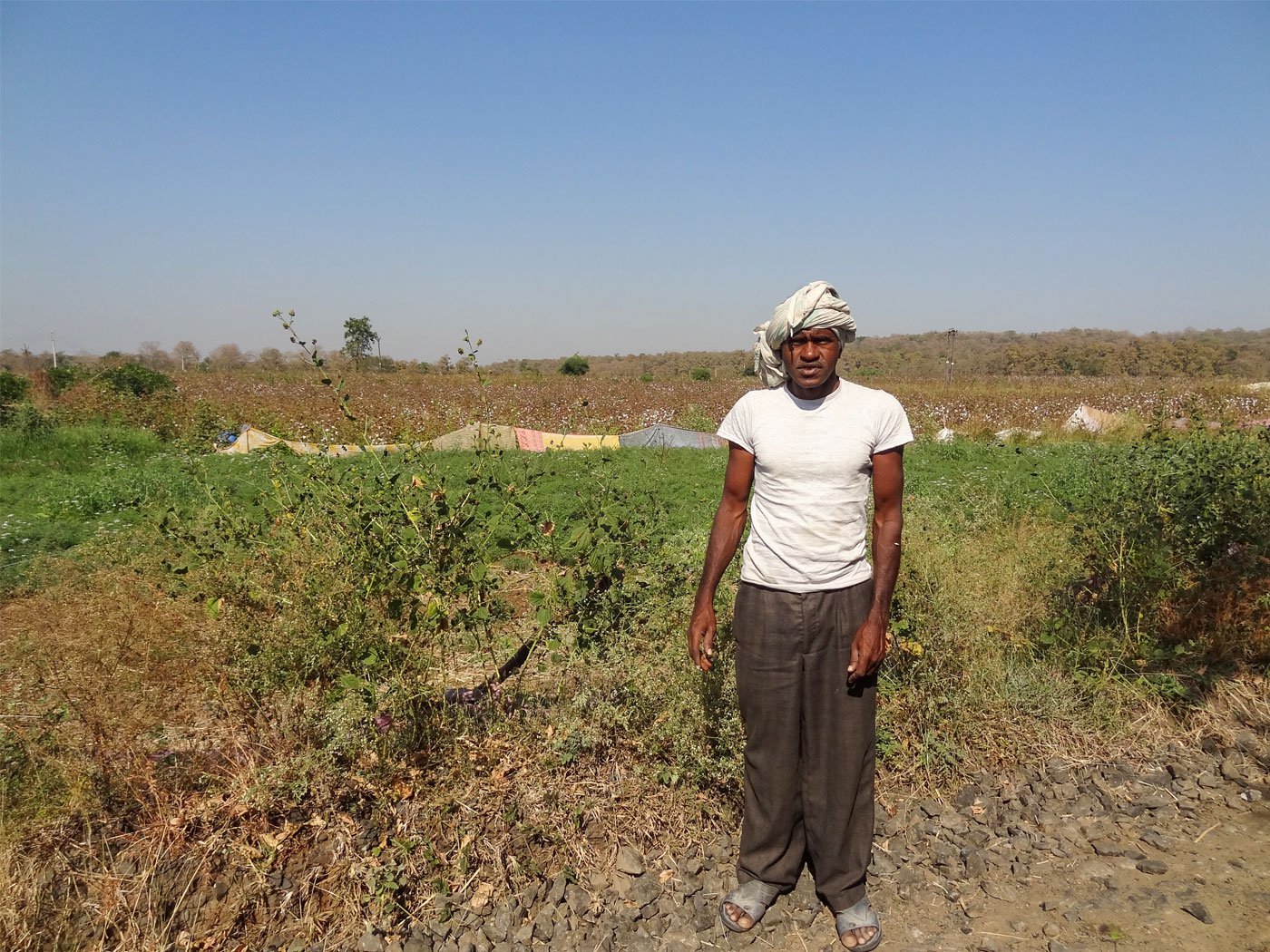
Left: In Dhamani village, fields where jowar and green gram crops were devoured by wild animals. Right: Here in Kholdoda village, small farmer Vithoba Kannaka has used sarees to mark his boundary with the forest
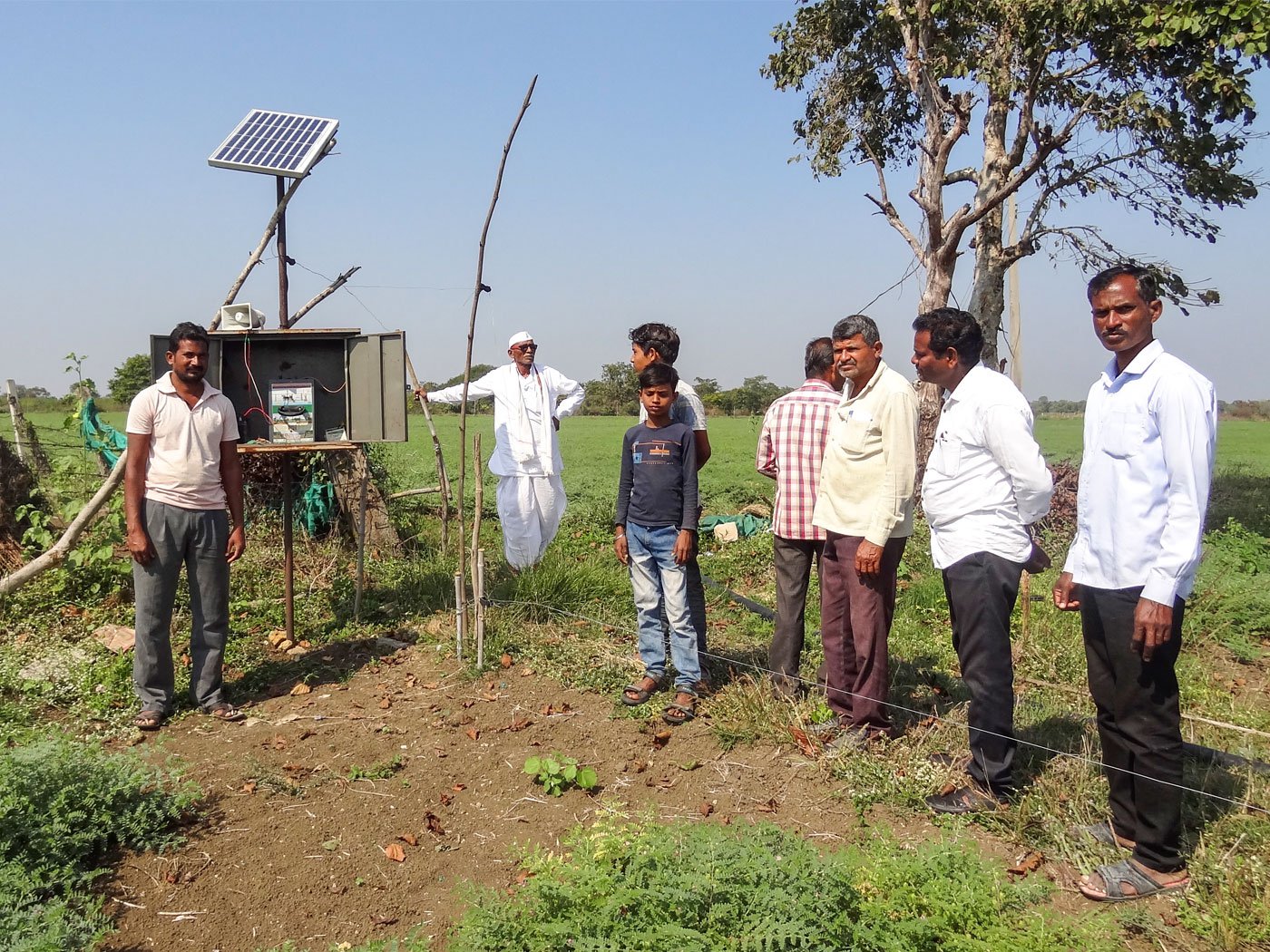
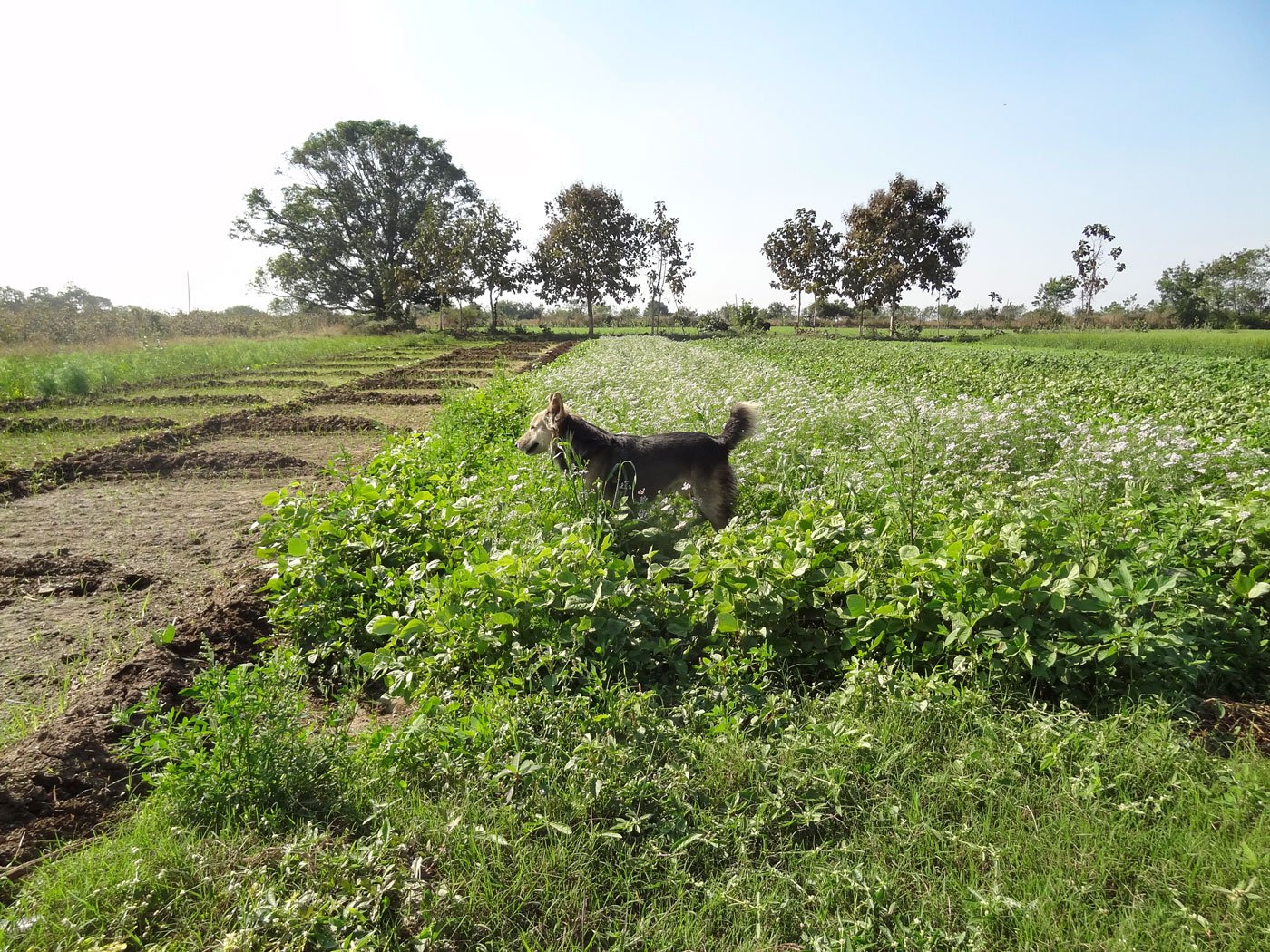
Left: Mahadev Umre, 37, is standing next to a battery-powered alarm which emits human and animal sounds to frighten raiding wild animals. Right: Dami is a trained dog and can fight wild boars
The situation is particularly alarming in eastern Maharashtra’s Vidarbha region comprising 11 districts, including Chandrapur. Vidarbha is home to some of India’s last-remaining protected forests, teeming with tigers and wild animal populations. The region also suffers a high degree of indebtedness and farmers’ suicides among rural households.
In 2022 alone, Chandrapur district registered the killings of 53 people by tigers and leopards, according to a statement by Maharashtra’s minister for forests, Sudhir Mungantiwar. In the last two decades, about 2,000 people – mostly in the TATR region – have died in attacks by wild animals in the state. The attacks are predominantly by tigers, black bears, wild boars and others. At least 15-20 ‘problem tigers’ – individual tigers in conflict with humans – have had to be neutralized – proof that Chandrapur is a major tiger-human conflict hotspot. There is no formal count of people injured in animal attacks.
Men are not alone facing off wild animals, women also confront them.
“We work in fear,” says Archanabai Gaikwad, a tribal farmer in her fifties in Bellarpar village in Nagpur district. She has spotted a tiger in her fields several times. “Usually, we leave the fields if we sense there’s a tiger or leopard around,” she says.*****
“They’ [wild animals] will eat plastic if we grow it on our farms!”
A cursory chat with farmers turns animated in the districts of Gondia, Buldhana, Bhandara, Nagpur, Wardha, Washim and Yavatmal. These days wild animals feast on green cotton bolls, they tell this reporter who travelled through the Vidarbha region.
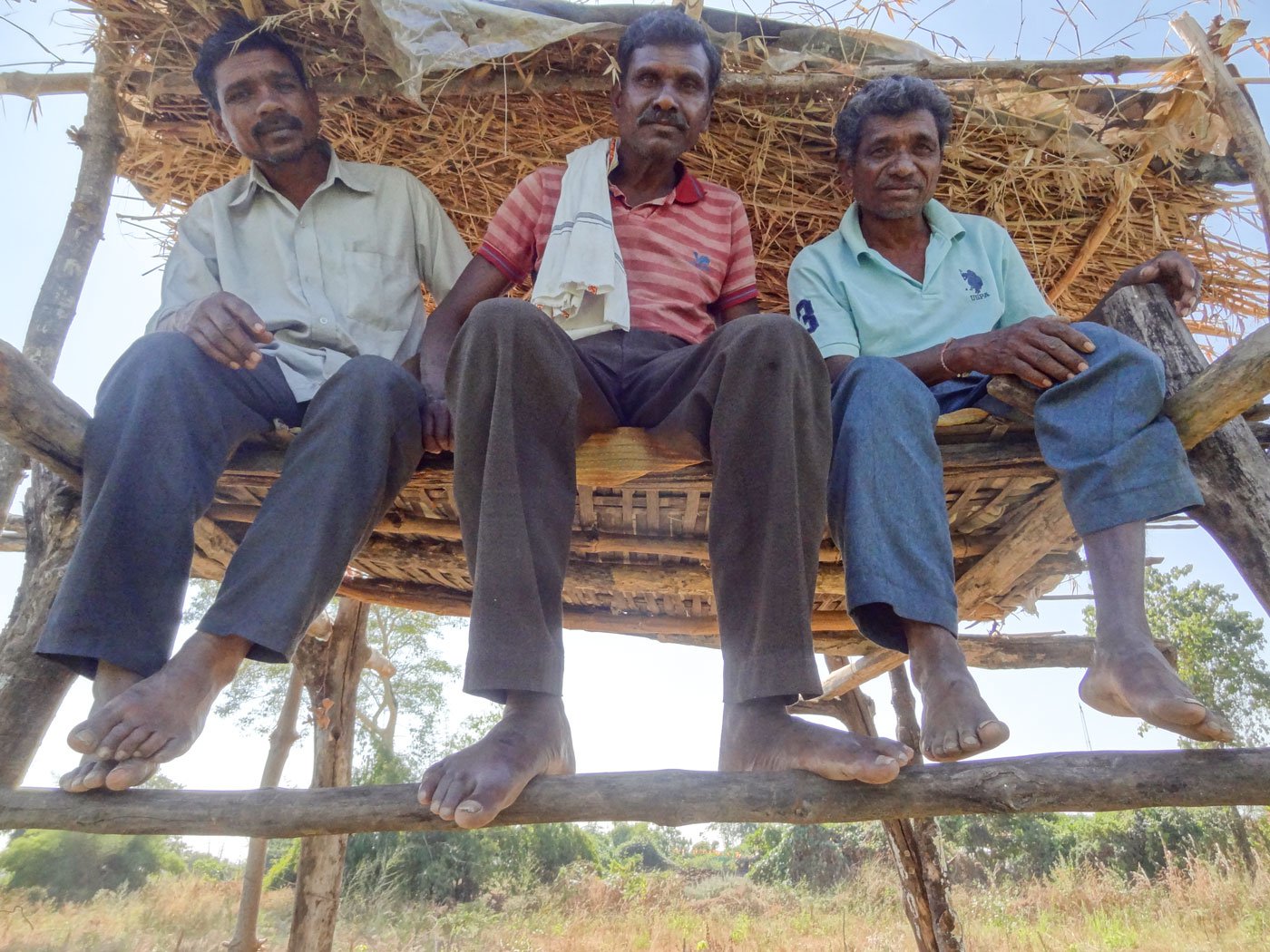
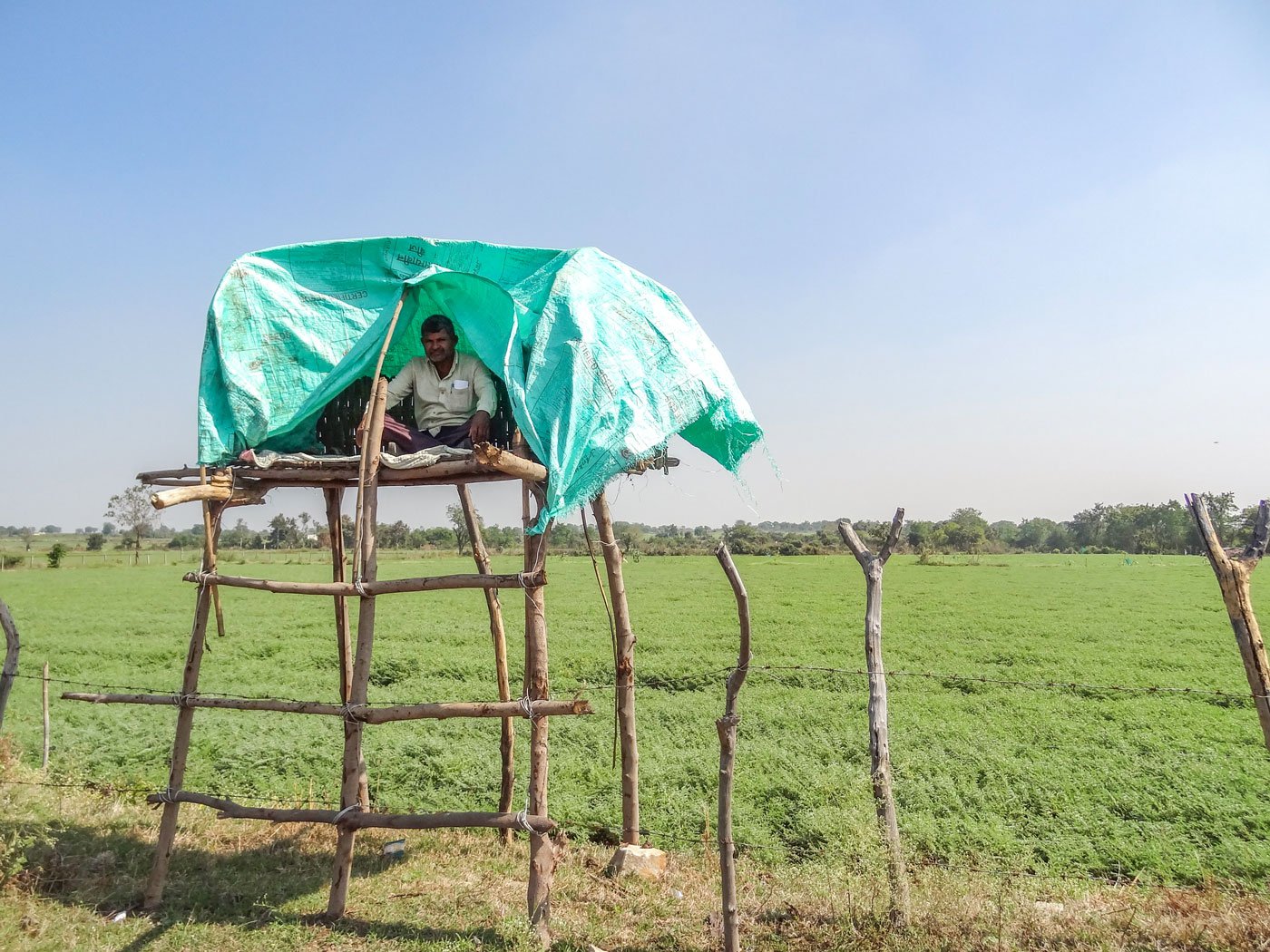
Left: Madhukar Dhotare, Gulab Randhayee, and Prakash Gaikwad (seated from left to right) are small and marginal farmers from the Mana tribe in Bellarpar village of Nagpur district. This is how they must spend their nights to keep vigil against wild boars, monkeys, and other animals. Right: Vasudev Narayan Bhogekar, 50, of Chandrapur district is reeling under crop losses caused by wild animals
“During harvest, we do nothing but stay on the farms day and night to protect the crop, even if there are risks to our lives,” says Prakash Gaikwad, a 50-year-old farmer from the Mana community in Bellarpar in a fringe village of TATR in Nagpur district.
“Even if we fall sick, we must stay on our farm, guarding our crops, otherwise we won’t harvest anything,” says Dattuji Tajane, 77, in village Chaprala, where Gopal Bonde lives. “There was a time I could sleep on my farm without any fear; not anymore; there are wild animals all over.”
This past decade, Tarale and Bonde have seen irrigation facilities develop in their villages in the form of canals, wells and borewells. This allowed them to diversify and cultivate two or three crops round the year in addition to the traditional cotton or soybeans.
The downside is obvious: lush green fields with standing crops mean abundant fodder and feed for herbivores such as deer, blue-bulls and sambars. With herbivores about, carnivores lurk just around the corner.
“One day,” Tarale remembers, “I was troubled by monkeys on the one hand and wild boars on the other; it was as if they had decided to put me to the test – as though they were teasing me.”
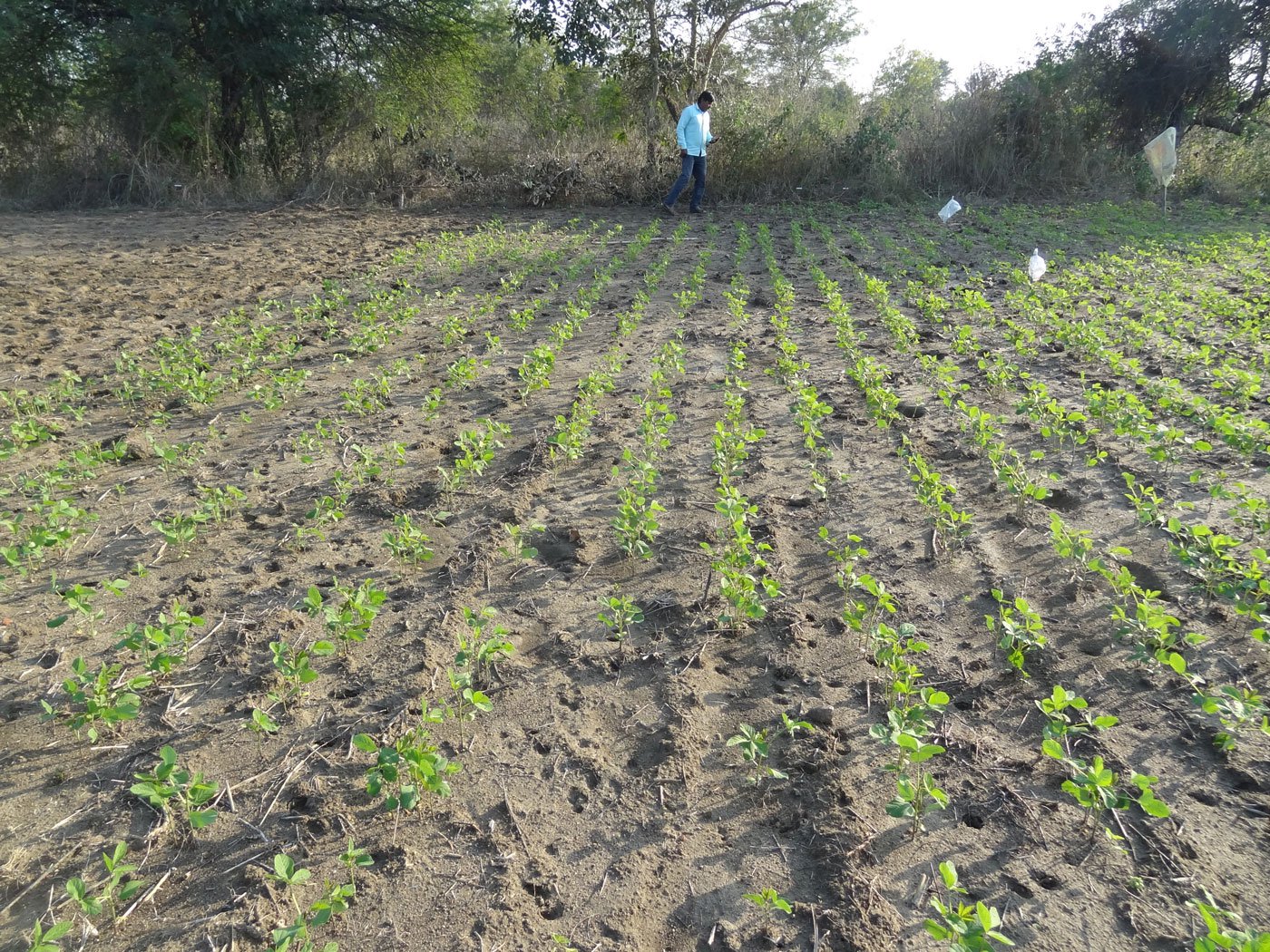
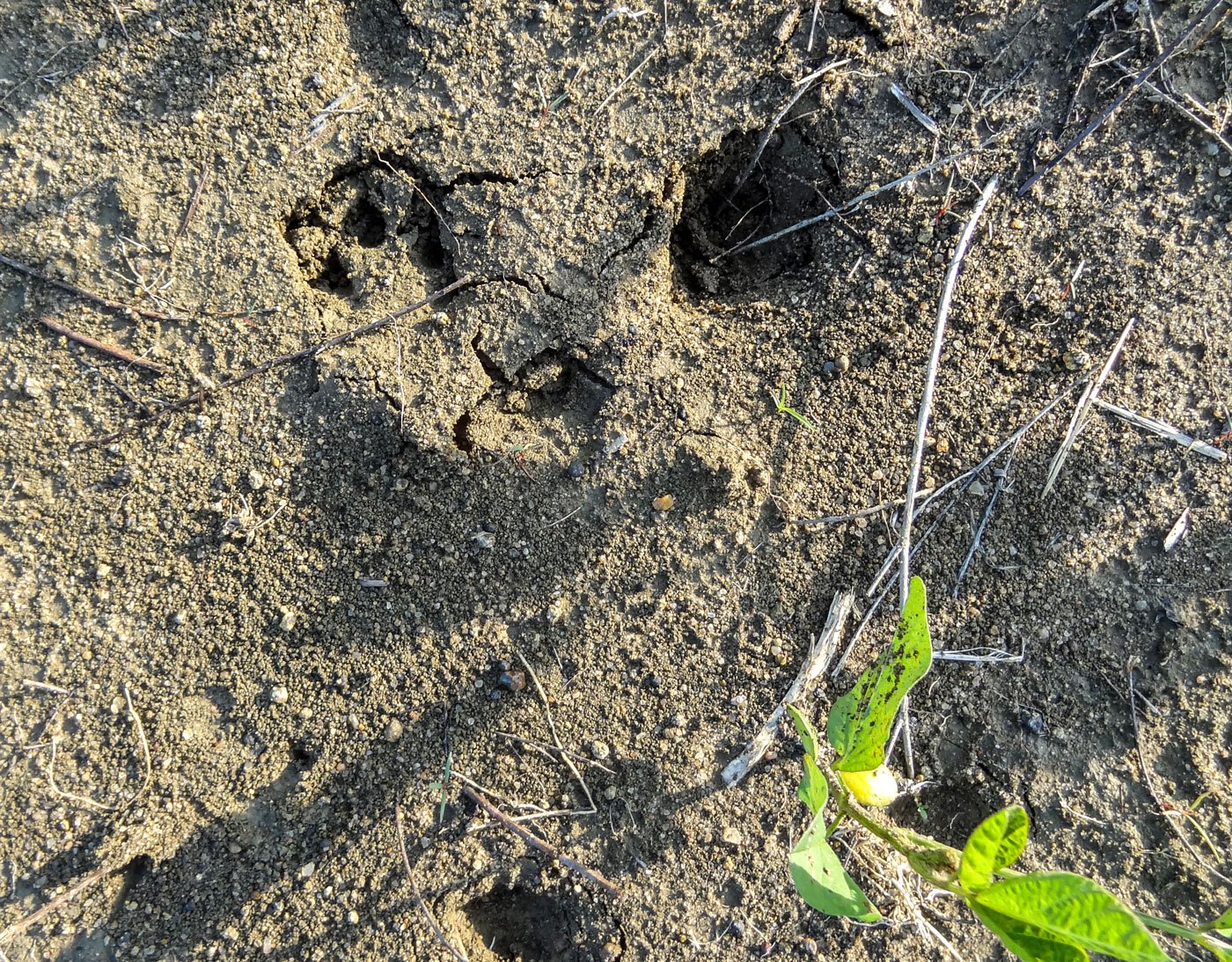
Gopal Bonde’s farms bear tell-tale pug marks of wild animals that have wandered in – rabbits, wild boar and deer
Walking around the farm, he shows us pug marks of about a dozen wild animals, including rabbits, on the wet black earth. They have shat, eaten crops, torn up the soybeans and uprooted green shoots.
“ Ata ka karta, sanga ? [Now, tell me, what to do!],” Bonde sighs.
*****
Even though Tadoba’s forests are a major focus for tiger conservation as a part of the central government’s Project Tiger programme, the area has witnessed the ceaseless growth of highways, irrigation canals and new mines. This has cut into protected forest areas, displaced people and disturbed forest ecology.
Mining is encroaching on areas that were earlier tiger territory. About two dozen of the over 30 active public and private sector coal mines in Chandrapur district have come up in the southern and western parts in the last two decades.
“Tigers have been seen near the coal mines or in the campus of the Chandrapur Super Thermal Power Station (CSTPS). These areas are the latest flashpoints of the man-animal conflict. We have encroached into their habitat,” says environmental activist and conservationist, Bandu Dhotre. According to the NTCA 2022 report on tiger estimates, the high concentration of mining activity in the Central Indian highlands poses a significant challenge to conservation.
The TATR is a part of the larger central Indian forest landscape with neighbouring forest divisions in Yavatmal, Nagpur and Bhandara districts. “It is in this landscape that conflicts with humans and tigers are maximum,” says the 2018 NTCA report.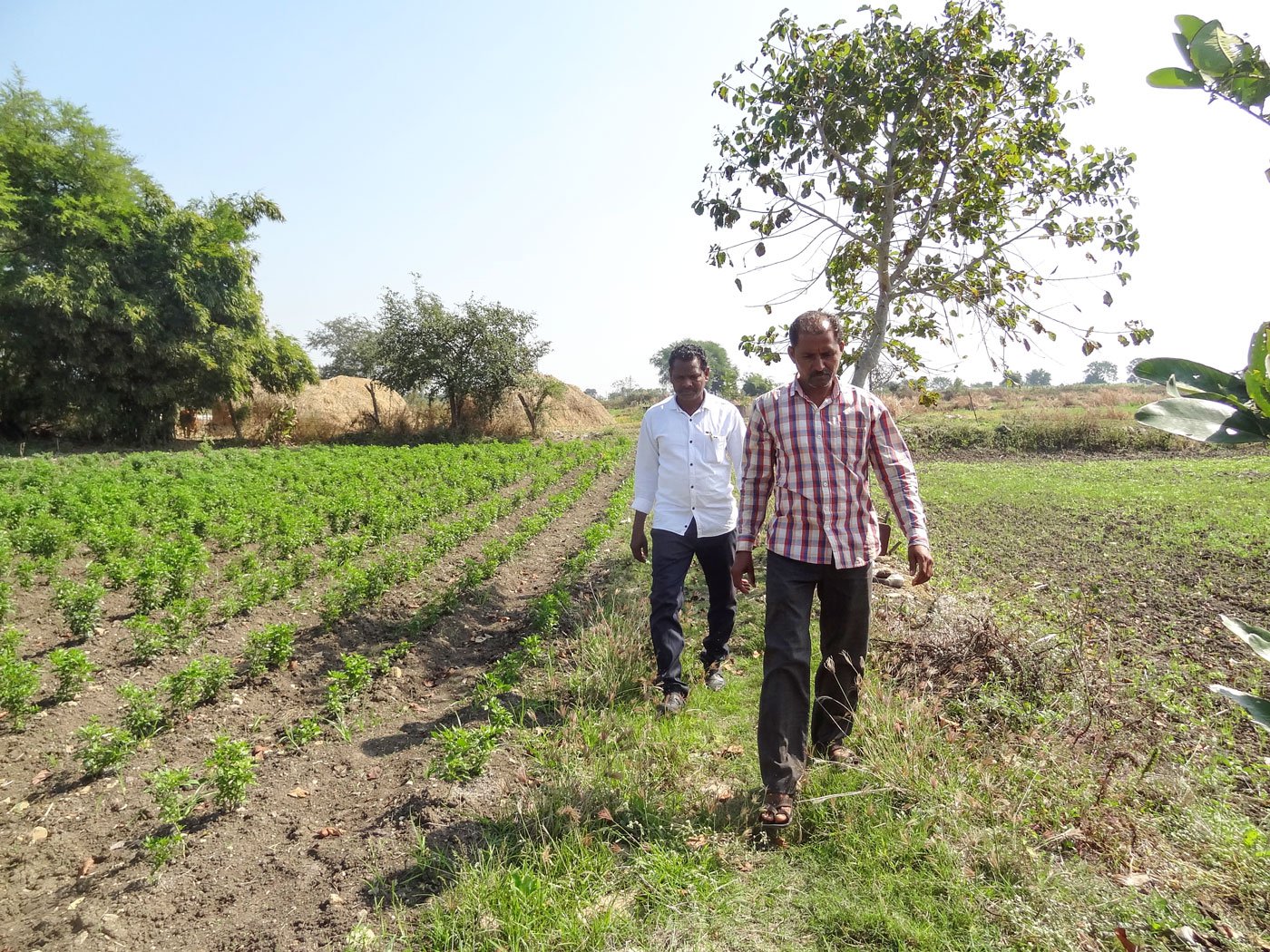
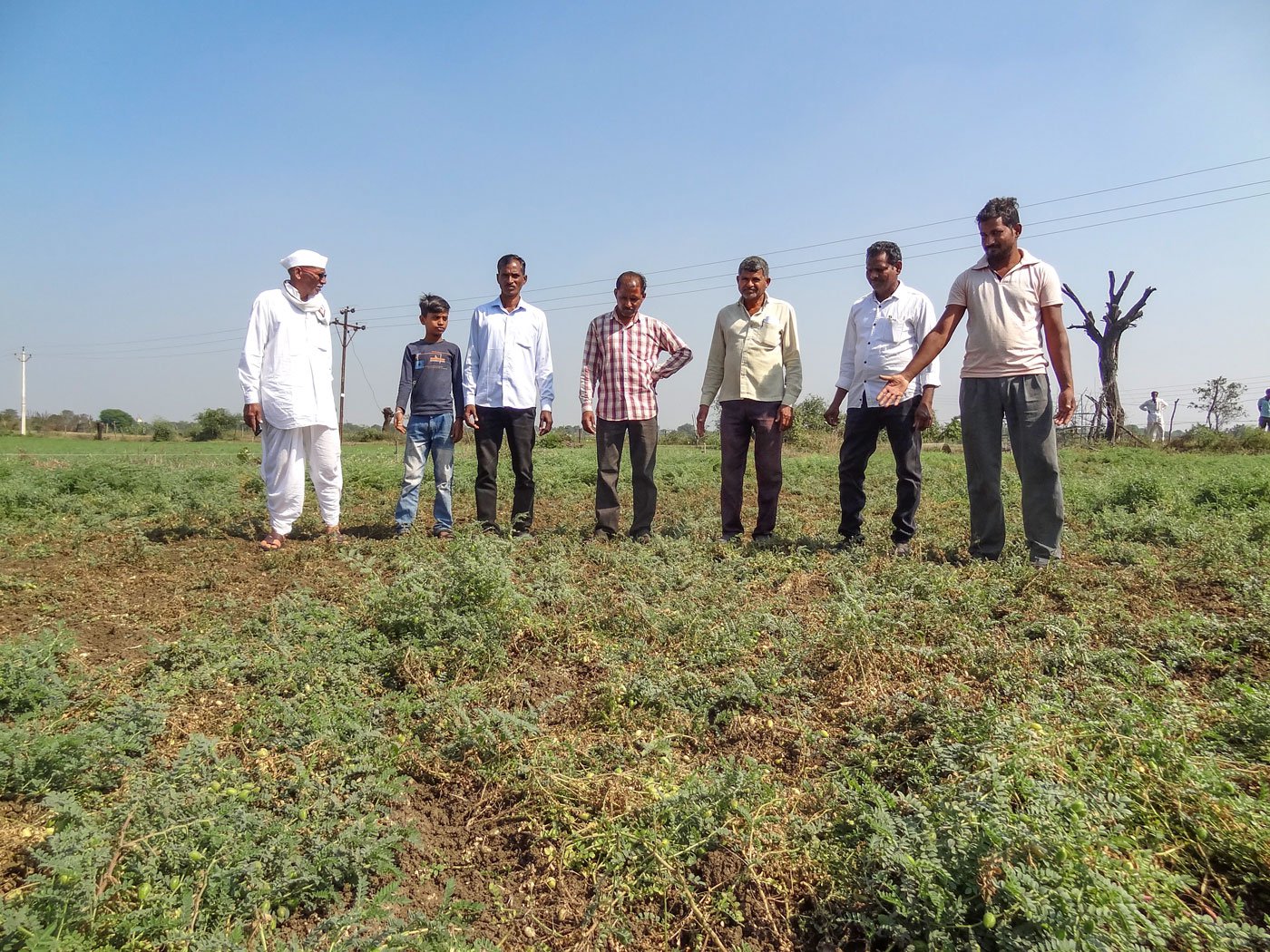
Namdeo Tarale (right) with Meghraj Ladke, a farmer from Dhamani village. Ladke, 41, stopped nightly vigils after confronting a wild boar on his farm. Right: Farmers in Morwa village inspect their fields and discuss widespread losses caused by tigers, black bears, wild boars, deer, nilgai and sambar
“The issue has huge national economic consequences for farmers as well as for the state’s conservation imperatives,” says Dr Milind Watve, a wildlife biologist and former professor at the Indian Institute of Science Education and Research (IISER), Pune.
While laws protect reserved forest areas and preserve wildlife, crop and cattle losses are being disproportionately borne by farmers. Crop damages caused by animal raids make farmers resentful, thereby adversely impacting conservation initiatives, Watve explains. Laws also prevent the practice of culling or eliminating undesirable animals from a herd such as those which are unproductive or not suited for breeding.
Watve conducted a field study between 2015 to 2018 with about 75 farmers in five villages around TATR. Through the study funded by the Vidarbha Development Board, he created a system for farmers to collectively report their comprehensive year-long losses owing to animal raids. He estimated that crop losses and financial damages were anywhere between 50-100 per cent – or a loss of between Rs. 25,000- Rs. 100,000 per acre per annum depending on the crop.
Unless compensated, many farmers stick to limited crop choices or even leave their fields barren.
The state forest department distributes Rs. 80 crore annual compensation to farmers for crop damages or cattle killed by wild animals. That’s what the then head of the forest force, the Principal Chief Conservator of Forests for Maharashtra, Sunil Limaye, told PARI in March 2022.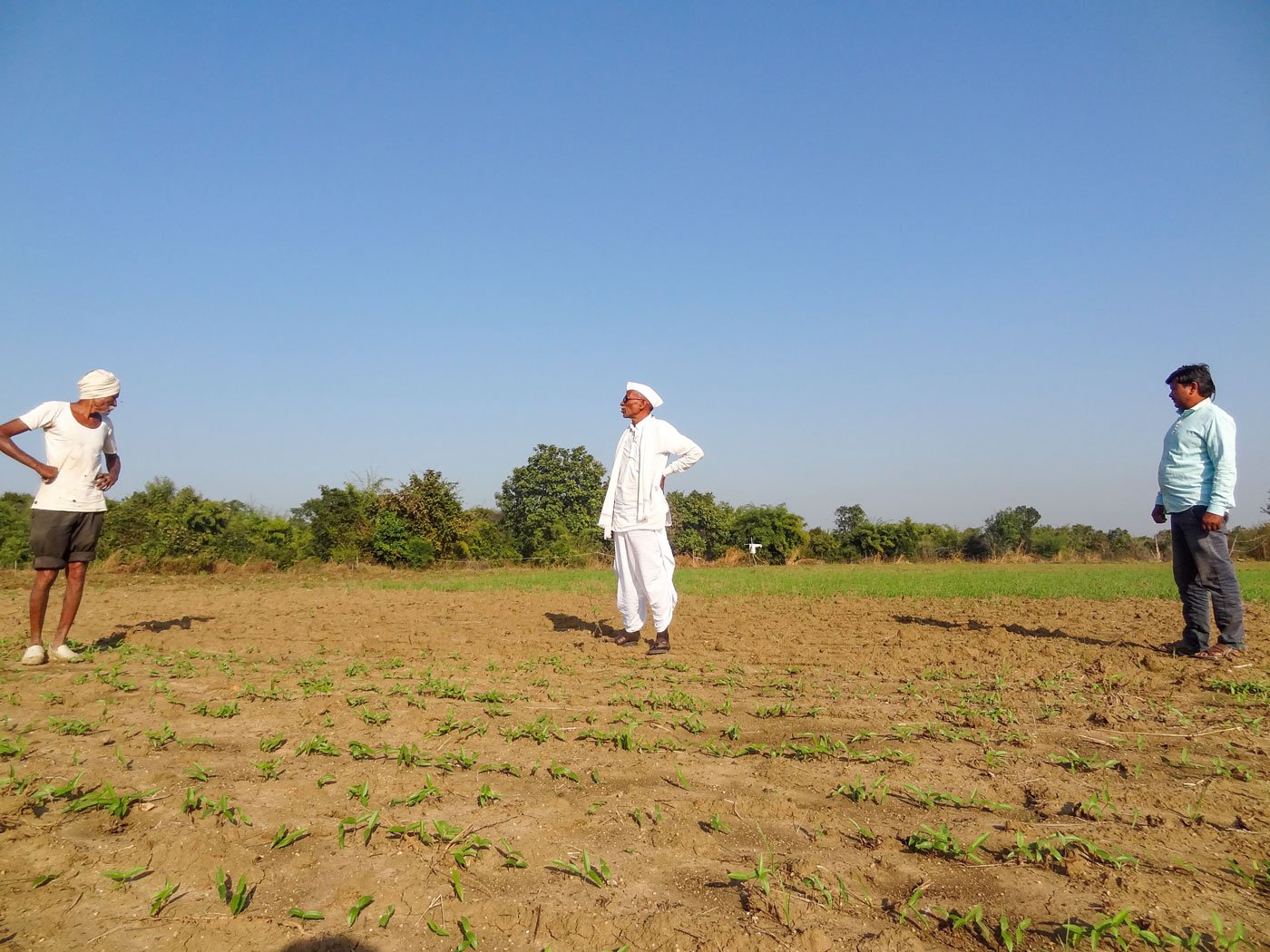
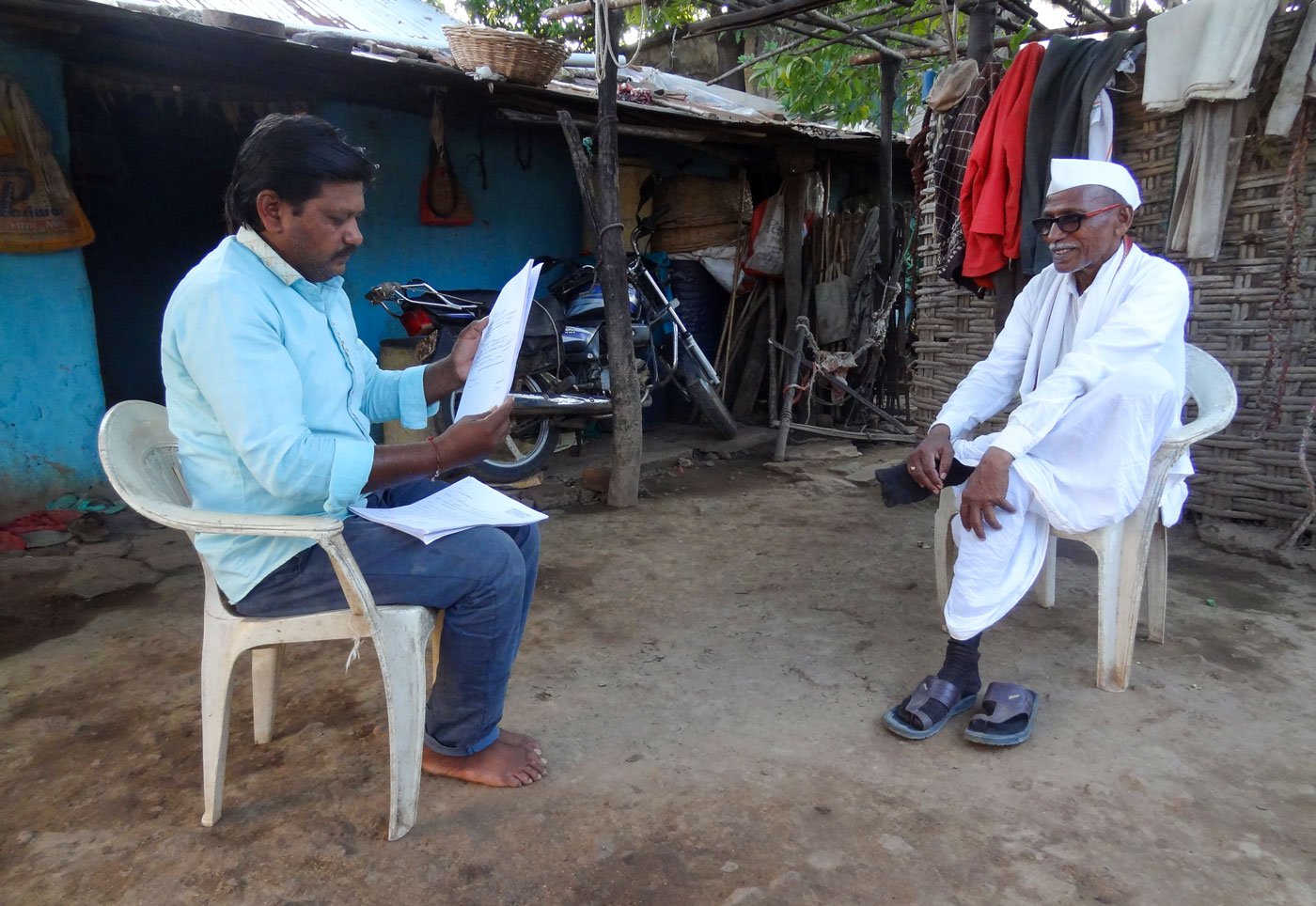
Gopal Bonde (right) with Vitthal Badkhal (middle) who has been trying to mobilise farmers on the issue. Bonde filed compensation claims about 25 times in 2022 after wild animals damaged his farm. Badkhal says that farmers usually don’t claim compensation because the process is cumbersome
“The current cash compensation is peanuts,” says Vitthal Badkhal, a septuagenarian crusader in Bhadravati taluka , rallying to mobilise farmers on the issue. “Farmers usually don’t claim compensation because the process is cumbersome and technically difficult to understand,” he explains.
Bonde lost more cattle, including a cow, a few months ago. In 2022, he filed compensation claims about 25 times. Each time he had to fill up a form, inform local forest and revenue department authorities, persuade local authorities to conduct a mandatory spot panchanama (or inspection), maintain records of his expenditures, and follow up on his claim submissions. It will be months before he receives any compensation, he says. “And it won’t cover up for all my losses.”
On a wintry morning in December 2022, Bonde takes us once more to his farm, verdant with newly sown green gram. Wild boars have already chewed through the tender shoots and Bonde to be uncertain of the fate of the crop.
In the months that followed he managed to salvage most of the crop barring a few patches that were likely devoured by a herd of deer.
Animals need food. So do the families of farmers like Bonde, Tarale and others. It’s on their farms where the two needs collide.